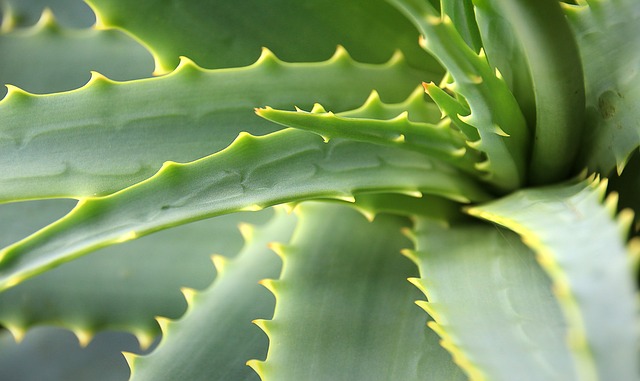 |  |  |  |  |
 |  |
Aloe arborescens is a low and strongly branching tree with a height of 2 to 3, sometimes 5 meters. In room conditions, aloe tree reaches 60-80 cm (up to 1 m) in height. The stems are erect, branching, in the lower part with numerous annular scars from fallen leaves. Numerous lateral shoots extend from the base of the stem, used for vegetative propagation. The leaves are sessile, alternate, greenish-gray, xiphoid, fleshy, 30-40 cm long, amplexicaul - they cover the stem with a wide base. The root system is fibrous. The roots are long, cylindrical, branched. The flowers are orange (40 mm long and about 5 mm wide), drooping, on thin long (2.5 cm) pedicels. Perianth simple, corolla-shaped, tubular, six-petaled in two circles. Aloe flower formula: RL3 + 3T3 + 3P3. In its historical homeland (South and tropical Africa), it blooms annually, forming rather long peduncles (up to 80 cm) with dense conical racemes of scarlet large flowers, up to 4 cm long. The fruit is a trihedral cylindrical box. Seeds numerous, grayish-black, triangular. In greenhouse conditions, it usually blooms in the winter months and is extremely rare; it is with this feature that its popular name "agave" is associated. In this case, seeds usually do not form.
Medicinal raw materials are fresh leaves collected from late October to mid-November. Juice is prepared from the lower and middle fresh leaves, which have reached 18 cm in length and three years old, they are washed in boiled water, cut into small, thin pieces (0.2-0.3 mm) and squeezed manually (in gauze) or with the help of a juicer. According to another technology, obtained by the above method, the juice is filtered, boiled at 100 ºС for 5-10 minutes, poured into containers, alcohol is added and left in a cool place for 14-15 days. To prevent the juice from turning dark under the influence of light and air, it is usually stored in a dark, cool place in dark glass containers.
Emodin (1.66%) and anthraglycoside were isolated from aloe arborescens. Aloe vera leaves and juice contain anthro derivatives: aloin, isobarbaloin, nataloin, homonataloin, rabarberone, little-studied resinous substances, enzymes, vitamins, phytoncides, polysaccharides, succinic acid, traces of essential oils and a number of minerals (K, Ca, Cu, Mg, Ba, Zn, Li, etc.).
MEDICINAL IMPORTANCE
Aloe juice has a bactericidal and bacteriostatic effect on many groups of microbes: streptococci, staphylococci, diphtheria, typhoid and dysentery sticks. Aloe has powerful wound healing properties, removes radionuclides, increases the body's immune-reactive abilities and defenses in the fight against infectious diseases, and is also an excellent biostimulator, contributing to the improvement of the body as a whole.
In folk medicine, aloe leaves and juice from them are used externally as a wound healing agent. In the form of irrigations and lotions, juice from fresh leaves is used to treat purulent wounds, trophic ulcers, burns, abscesses, boils. In case of hair loss, aloe is applied with wine on the head or washed with its juice along with vinegar. With dermatitis of the head after irradiation, compresses with aloe juice relieve pain, accelerate tissue repair and hair growth. In gynecology, a swab moistened with fresh aloe juice is inserted into the vagina during cervical erosion. Inside, an extract from aloe leaves is recommended as a symptomatic remedy for the treatment of pulmonary tuberculosis, vascular diseases, in menopausal and postmenopausal periods, as well as bronchial asthma, inflammatory diseases of the female genital area, scleroderma, inflammatory diseases of the peripheral nervous system. Take fresh aloe juice 1 teaspoon 2-3 times a day 20-30 minutes before meals.
